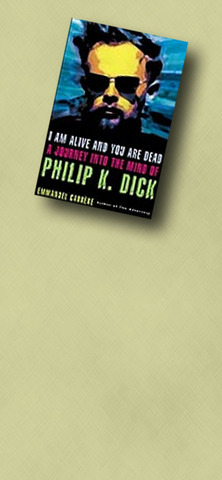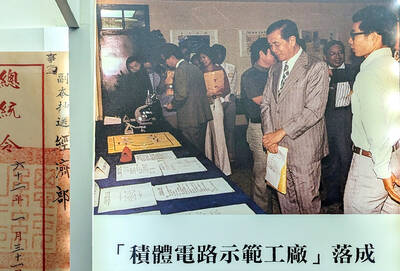Often, people claim to remember past lives; Philip K. Dick once told an audience of admirers in France, where he was considered a literary genius, "I claim to remember a
different, very different present life." The notion that he lived two separate and simultaneous existences, one conscious, the other glimpsed in moments of disorienting revelation akin to LSD flashbacks, was only one of many delusions that beset him in his relatively short, tortuous life. His first novel was called Time Out of Joint, and its title, in retrospect, seems self-
fulfilling

Like J.G. Ballard's, Dick's reputation rests on the creation of dystopian fictions that foresaw a world something like the one we now live in, a world of conspiracy theories, clones, untrammelled consumerism, viral terrorism and virtual reality. His most widely known story, Do Androids Dream of Electric Sheep?, crossed into the mainstream via Hollywood, where it was retitled as Blade Runner by director Ridley Scott and given a happy ending wherein Harrison Ford, a surviving human, rides off into the nuclear sunset with his android lover.
When the movie money started rolling in, Dick, who had survived four marriages and a prolonged bout of amphetamine psychosis, was almost at the end of his tether. He emerged from one of his many spells in rehab, convinced that a spirit guide was responsible for his late financial good fortune, and began giving the money away to Christian-run charities.
Like L. Ron Hubbard, the science-fiction writer who founded the Church of Scientology, Dick's life sometimes seemed weirder even than his fictions, while his obsessions and neuroses found their way into stories that redefined the genre.
Emmanuel Carrere has written what he calls "a very peculiar book, a kind of imaginative biography which purports to depict the life of Philip K Dick from the inside." Sometimes, it appears almost novelistic in its rendering of Dick's thoughts, its re-creation of his love affairs and its litany of anecdotes concerning his pharmaceutically fuelled lifestyle in the late 1960s and early 1970s.
One chapter, entitled "Freaks," is made up of such recollections, each one beginning with the phrase, "Another time...," as in, "Another time, someone got the idea of painting all the windows in Phil's house black," or "Another time, a girl who had lived with them for a week went into a coma during a bad acid trip."
The effect here is conversational, almost throwaway, intentionally so, though to what end I am not altogether sure. Perhaps Carrere wants us to experience the myth of Philip K. Dick, the terminal stoner, the way he experienced it, in a wealth of remembered anecdotes, hazy and cumulative.
More ominously, there is nothing here in the way of an index or footnotes, none of the usual evidence of deep research that gives a biography the solid stamp of authority. And though Dick was the subject of several marathon interview sessions, most notably by Rolling Stone magazine journalist Paul Williams, and, towards the end of his life, by science-fiction critic Charles Platt, we seldom hear his voice or see his words appear directly on the page.
For all that, though, I Am Alive and You Are Dead is an intriguing read, well-paced and packed with evidence of Dick's eccentricity, which was of the obsessive and neurotic kind and must have made him impossible to be around for any length of time.
As a troubled and pampered child, constantly packed off to psychiatrists of dubious provenance by his fawning mother, Dick submerged himself in the stories of H.P. Lovecraft, the most coldly
pessimistic of all fantasy writers.
In 1954, two years before Don Seigel's Cold War parable, Invasion of the Body Snatchers, arguably the first modern sci-fi movie, he wrote a short story in which a boy is convinced that his father has been incinerated and replaced by an alien impostor. All his greatest fictions were prescient in their countenancing of the deep, unconscious collective fears of an essentially puritanical America which was, and remains, profoundly ill at ease with the speed of scientific progress.
Ultimately, Dick was a great writer despite himself and his methodology, which involved ingesting a gargantuan amount of amphetamines and working manically on a novel until it was finished.
Perhaps because of his sustained drug abuse, he lived, as Carrere puts it, in a state of perpetual fear. He was afraid of the FBI, who visited his house more than once, and of abduction by aliens, a fate he saw as inevitable. Towards the end of his life, alone and reclusive in a ranch house in southern California, he sat in the dark, listening for hours to the Grateful Dead and devotional classical music, hallucinating about swirling pink mists out of which emerged angry creatures with three eyes. It was as though his work had invaded his life and his fictional creations his mind.
Willfully unpredictable to the end, Dick received Christian last rites on his death bed after a stroke. He was buried underneath a gravestone that had borne his name for the entire 53 years of his life, his parents having assumed that he would soon follow his malnourished three-week-old twin sister into the earth. But he survived, and the 50 novels published in his lifetime are but a fraction of the work he left behind.
Carrere's labor of love is as good a place as any to start trying to understand the enigma of Philip K. Dick, one of the few postwar novelists who deserves the title "visionary."

Oct. 27 to Nov. 2 Over a breakfast of soymilk and fried dough costing less than NT$400, seven officials and engineers agreed on a NT$400 million plan — unaware that it would mark the beginning of Taiwan’s semiconductor empire. It was a cold February morning in 1974. Gathered at the unassuming shop were Economics minister Sun Yun-hsuan (孫運璿), director-general of Transportation and Communications Kao Yu-shu (高玉樹), Industrial Technology Research Institute (ITRI) president Wang Chao-chen (王兆振), Telecommunications Laboratories director Kang Pao-huang (康寶煌), Executive Yuan secretary-general Fei Hua (費驊), director-general of Telecommunications Fang Hsien-chi (方賢齊) and Radio Corporation of America (RCA) Laboratories director Pan

President William Lai (賴清德) has championed Taiwan as an “AI Island” — an artificial intelligence (AI) hub powering the global tech economy. But without major shifts in talent, funding and strategic direction, this vision risks becoming a static fortress: indispensable, yet immobile and vulnerable. It’s time to reframe Taiwan’s ambition. Time to move from a resource-rich AI island to an AI Armada. Why change metaphors? Because choosing the right metaphor shapes both understanding and strategy. The “AI Island” frames our national ambition as a static fortress that, while valuable, is still vulnerable and reactive. Shifting our metaphor to an “AI Armada”

When Taiwan was battered by storms this summer, the only crumb of comfort I could take was knowing that some advice I’d drafted several weeks earlier had been correct. Regarding the Southern Cross-Island Highway (南橫公路), a spectacular high-elevation route connecting Taiwan’s southwest with the country’s southeast, I’d written: “The precarious existence of this road cannot be overstated; those hoping to drive or ride all the way across should have a backup plan.” As this article was going to press, the middle section of the highway, between Meishankou (梅山口) in Kaohsiung and Siangyang (向陽) in Taitung County, was still closed to outsiders

The older you get, and the more obsessed with your health, the more it feels as if life comes down to numbers: how many more years you can expect; your lean body mass; your percentage of visceral fat; how dense your bones are; how many kilos you can squat; how long you can deadhang; how often you still do it; your levels of LDL and HDL cholesterol; your resting heart rate; your overnight blood oxygen level; how quickly you can run; how many steps you do in a day; how many hours you sleep; how fast you are shrinking; how